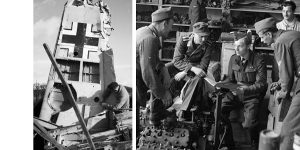Past Talks : January 2022
“Taming Eagles – Disarming the Luftwaffe, 1945-1948” by Chris Rogers
By the start of 1945 German fighting strength was being sapped, but their technology had been daunting throughout. By February, the RAF was already planning to locate and dispose of the aircraft, ordnance and equipment of the Luftwaffe and set up ten dedicated Disarmament Wings. One of these was No.8401 Air Disarmament Wing to which the father of our speaker, Chris Rogers, was attached. On 7 May 1945, the Wing set off to Ostend. The Wing drove across Europe to the Baltic coast of Germany where it was split into three squadrons. No.2 Squadron was allocated the military proving ground, Erprobungsstelle (E-stelle) of Travemünde, 60 miles northeast of Hamburg and close to Lübeck.
Travemünde was one of four E-stelle, located at the mouth of the River Trave. On the opposite side is Priwall, where an airfield was built in 1913, attracting aircraft designers Anthony Fokker and Ernst Heinkel. They covertly developed several advanced and radical aircraft projects, including the giant, twelve-engined Dornier Do X seaplane. The site was bought by the government in 1932, and converted to an E-stelle, with all public access prohibited. In 1936, Germany held acompetition to identify a replacement for obsolete bi-plane fighter aircraft. Four entries were compared by the E-stelle, those from Arado, Focke-Wulf, Heinkel and Messerschmitt. The Messerschmitt Bf109 was a clear winner, becoming the German mainstay fighter in the forthcoming war. In 1938 the E-stelle specified the air wing for the German aircraft carrier Graf Zeppelin, including modified versions of the Bf109 fighter and the Junkers 87 Stuka dive-bomber. They also conducted trials of the Fiesler Fi 156 Storch (short takeoff and landing communications aircraft) for deck landing.
The coastal location of Travemünde-Priwall made it ideal for maritime related projects and the E-stelle evaluated every amphibious aircraft type, employing 1,400 staff plus around 700 forcedlabourers on a wide range of projects including: navigation and communications; air sea rescue and life saving techniques and equipment; engine starting equipment; smoke and fog generating systems; the camouflage colours and patterns for every Luftwaffe aircraft type operating in every conceivable theatre of war
Chris Rogers illustrated the well-known Blohm und Voss BV 138 Seedrache (Sea Dragon). A hugehangar was built at Priwall to house aircraft such as the enormous six-engined Blohm & Voss BV 222 Viking, which was 150ft long with a wingspan of 120ft. As well as modifications to the Bf109 fighter for embarked operations, trials were carried out to identify the effectiveness of the Fw 190 in the torpedo role. Many rare or even unknown aircraft types were discovered, including the FGP 227, a faithful fifth-scale model, again with six engines, to provide data for the development of the BV238 – which was even larger than the BV 222 Viking. One example of the BV 238 was built, but it was caught on open waters and destroyed by allied fighters.
Another rare type discovered was the BV155 experimental high-altitude interceptor. It featured a turbocharger, supercharger and a pressurised cockpit, enabling it to fly up to 50,000ft. All three examples of the BV155 were captured by 8401 Wing and one of these is the Smithsonian collection in Washington. 8401 Wing tracked down industrial science and technology targets before they were destroyed and traced the specialist personnel associated with them. Among these targets was the Philips subsidiary Valvo factory, specialising in the manufacture of electronic valves for the Wehrmacht and for Kriegsmarine U-boats. At the Hamburg Shipbuilding Research Institute, the Wing encountered a two-storey vertical water tunnel, built to test propellers for air bubble cavitation. Materials including missiles and a high-speed camera were discovered hidden and scattered in barns, shops, and even an orphanage.
At the close of all of 8401 Wing’s operations, the site was returned to civilian use. Today, Travemünde it is a beach resort. Thank you Chris Rogers for sharing all your research and delivering such an engrossing talk on a different, but critical slant of WW2.

